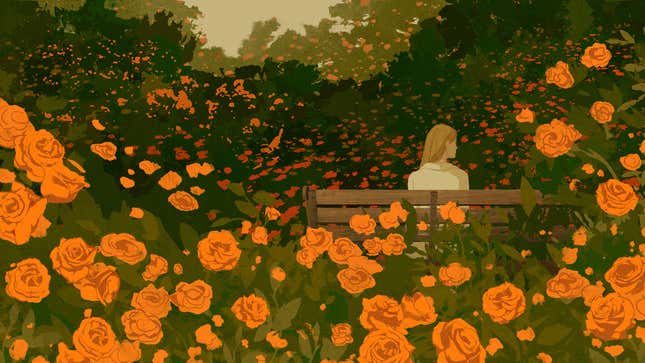
Image: Angelica Alzona
At the entrance to the park, there was a green wooden sign, seemingly freshly painted, with carved yellow letters that read, “MORCOM ROSE GARDEN.” This is not a particularly meaningful detail, but it seems an appropriate beginning for a story that has no point.
I had come to this garden, a public park in a residential neighborhood in Oakland, California, in search of nothing. I wanted to do a thing without aim. Stepping into the garden, I startled a pair of wild turkeys—their heads snapping to attention, the ruffled, pink flesh dangling over their beaks jiggling obscenely. One of them reared up, opening wide its iridescent wings: flap, flap, flap.
I walked along a cement path flanked on either side by roses the color of creamsicles and bubblegum. Then I turned a corner to climb a staircase alongside a cascading series of pools of water green with algae. Every few steps brought a new, insane variety of acid-trip rose. I resisted the impulse to whip out my phone for photos, and realized there was no way that I would remember all the different varieties or their placement in the garden. The journalist in me panicked; I considered grabbing my notebook and pen, but that would be too much of a “something.” I was already straining the bounds of this experiment by being determined to write about it. How do you do nothing without expecting anything from it?
How do you do nothing without expecting anything from it?
This impossible, paradoxical idea of pursuing nothing had burrowed into my brain ever since reading Jenny Odell’s How to Do Nothing: Resisting the Attention Economy. It’s a complex, ambitious, and principled book that has chiefly gotten attention for its critique of social media: Odell, an artist and teacher at Stanford University, laments that “many of us find our every last minute captured, optimized, or appropriated as a financial resource by the technologies we use daily,” that we “submit our free time to numerical evaluation, interact with algorithmic versions of each other, and build and maintain personal brands,” and that we rely on “communication” platforms that remove context and “reward shouting and oversimplify reaction… having a ‘take’ after having read a single headline.”
But the book makes other, much less fashionable arguments in favor of acts and ethos that counteract a “captured, optimized, or appropriated” existence: bioregionalism (essentially, a knowledge of, and sense of responsibility to, a local ecosystem), meaningful community-building outside of big tech’s watchful eyes, and fostering a sense of historical place (she writes a great deal about Northern California’s indigenous Ohlone people). How to Do Nothing isn’t an anti-technology treatise so much as an argument against the mechanistic, soul-deadening march of productivity. “What the tastes of neoliberal techno manifest-destiny and the culture of Trump have in common is impatience with anything nuanced, poetic, or less-than-obvious,” Odell writes.
Odell’s “nothing” isn’t apathy: It’s only within the frameworks of capitalism and the attention economy that, say, developing a familiarity with native plants counts as a zero. She emphatically makes the case for sitting, thinking, observing, and clearing the mind in nature, or in close proximity to it, as a way to “resist in place” (as opposed to running off to a utopian commune, a flawed fantasy to which she develops an entire, fascinating chapter). It can be a way to recharge enough to actually “do something” in the political, activist sense. Odell, who lives in Oakland, also writes about her past-time of bird-watching, whether it’s the black-crowned night herons that sit perched by the KFC in her Oakland neighborhood or the crows that she’s taught to dive for the peanuts she tosses off her balcony (really, they seem to have taught her to throw them).
Odell also writes about her frequent visits to this very garden that I am sitting in. “There are probably a hundred possible ways to wind your way through the garden, and just as many places to sit,” she writes. “Architecturally, the Rose Garden wants you to stay a while.”
Since I also live in the Bay Area, and since I am always looking for ways to exploit my job in the pursuit my own obsessions, I spent weeks after reading How to Do Nothing thinking in the back of my mind about reaching out to Odell, arranging a local bird-watching trip, a hike in the woods, a sit in the Rose Garden, where I would interview her about the book. I realized, though: I didn’t want to get into nature only to talk with her about How to Do Nothing. If felt like a superficial set dressing for a traditional author profile, a cheapening of her thesis into my colorful lede. I didn’t want to talk about the book. Instead, I wanted to do “nothing.”
-

-

-

-

-

-

-

-

-

-

-

-

-

-

-

-

-

-

-

-

-

-

-

-

-

-

-

-

-

-

-

-

-

-

-

-

-

-

-

-








































